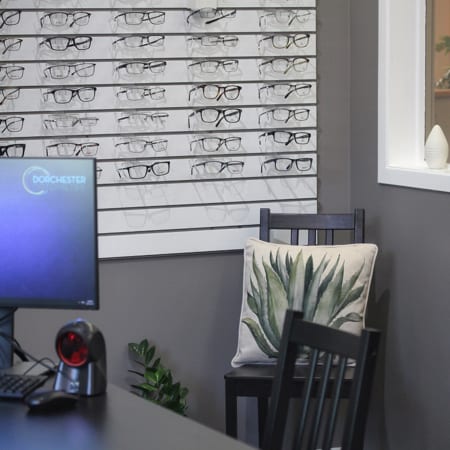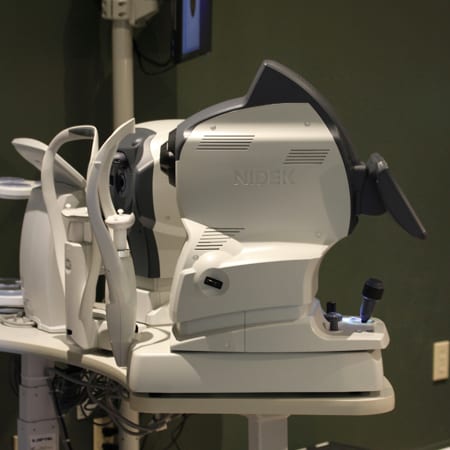Protecting Your Long-Term Vision
Eye diseases manifest in various forms, and beyond updating your prescription, your eye exam at Dorchester Optometry serves as an important check-in for early signs of eye disease. Many eye diseases can only be detected through a comprehensive eye exam, emphasizing the importance of early detection and treatment.
Regular eye exams help us identify and monitor subtle changes in your vision and eye health, which may indicate the presence of eye diseases.
Your vision is precious, and we aim to help preserve it—schedule your next appointment online today.

Early Detection & Treatment
The sooner we detect signs of eye disease, the faster our team can formulate a personalized treatment plan to safeguard your vision. Our use of optical coherence tomography angiography (OCTA) retinal imaging and other diagnostic technology helps us recognize early signs of eye disease.
Regular eye exams are instrumental in early detection, allowing us to proactively find solutions.


Our Diagnostic Technology
The diagnostic stage is an important step in our eye disease management process. Through our technology, we can get a clearer picture of your eyes and begin preparing a personalized treatment plan.
To aid in the early detection of eye diseases, we integrate modern diagnostic technology into our comprehensive eye exams.
Ask our team about our technology today—we’re more than happy to answer any questions you may have.
OCTA is a noninvasive imaging technique that allows us to visualize blood vessels in the retina, providing detailed images without invasive procedures. This technology aids in diagnosing and monitoring eye conditions like diabetic retinopathy, age-related macular degeneration, and glaucoma.
OCTA technology uses low-coherence interferometry to capture high-resolution, cross-sectional images.
Using non-contact and Goldmann applanation tonometry, we can measure intraocular pressure. These methods are crucial in detecting glaucoma, a group of eye conditions that can cause optic nerve damage.
Corneal topography accurately maps the cornea’s shape, helping detect conditions like astigmatism, keratoconus, and corneal irregularities. This noninvasive technique aids in contact lens fitting and refractive surgery evaluations.
AdaptDx Pro is an automated dark adaptometer that measures dark adaptation speed. This tool assists in diagnosing and monitoring age-related macular degeneration, providing valuable insights into overall eye health.
By measuring macular pigment density, we can actively monitor and protect this vital pigment, assess the risk for vision loss, and design personalized treatment plans.
Retinal photography captures a comprehensive view of your eye in a single image, enabling the early detection and treatment of eye diseases with precision.
The Different Forms of Eye Disease
Understanding various forms of eye disease empowers our patients to recognize the signs and symptoms early on. Patient education is an important aspect of our practice, and we always aim to help our patients gain a better understanding of their eyes and vision.
Eye disease can come in many different forms, but the good news is that we can help manage them.
Your eye health is our priority, and after the diagnostic stage, we want to help you move toward long-term healthy vision. Scheduling a detailed eye exam early can make a world of difference when it comes to successful treatment.
Age-related macular degeneration (AMD) is a progressive disease affecting central vision. Different types include subclinical AMD, dry AMD, and wet AMD, each requiring a different type of attention.
We diagnose and monitor AMD with our technology to get a more detailed look at how it’s affecting your vision. Consistent eye exams, adjusting your diet, and giving up smoking are also effective prevention methods for AMD.
Cataracts refer to a clouding of the eye’s lens, leading to symptoms like blurry vision and decreased night vision.
If cataracts progress to a later stage and prevent you from going about your daily activities, such as reading or driving, cataract surgery is the only option to remove them.
Glaucoma is a group of eye conditions that cause optic nerve damage that can lead to vision loss if not detected early. Damage from glaucoma can be caused by high pressure in the eye, known as intraocular pressure.
We test for glaucoma using non-contact tonometry and Goldmann applanation tonometry. Regular eye exams are key in monitoring changes.
Flashes and floaters happening occasionally are common, but sudden appearance may indicate a retinal tear or detachment, requiring prompt attention. If you notice a sudden influx of flashers and floaters, contact your eye doctor.
Diabetes increases the risk of eye diseases like cataracts and diabetic retinopathy. Diabetic retinopathy is a condition that causes damage to the blood vessels of the retina. This damage is caused by a buildup of excess sugar in your blood and can lead to a number of health issues.
Diabetic eye exams are crucial for early detection.
Conjunctivitis, commonly known as pink eye, can appear in viral, bacterial, and allergic forms. Timely treatment can make a significant difference in managing your symptoms and limiting discomfort.
Dry eye, an inflammatory condition, results from inadequate tear production or poor-quality tears. Symptoms include excessive tearing and discomfort. Learn about dry eye solutions on our Dry Eye Therapy page.
Keratoconus is a progressive disease affecting the cornea’s shape. While the exact cause is still unknown, it is believed to be influenced by genetic factors and environmental triggers.
It requires early detection for effective management and can be corrected with specialized contact lenses.
Uveitis is an eye disease characterized by inflammation of the uvea, the middle layer of the eye. This condition can cause discomfort, blurred vision, redness, and light sensitivity.
Early detection is important for managing uveitis and preventing potential complications. Regular eye exams and immediate medical attention are essential for preserving your ocular health.
Epiretinal membrane is a condition that affects the retina, the light-sensitive tissue at the back of your eye. This condition occurs when a thin layer of scar tissue forms on the surface of the retina, leading to various vision problems
If the symptoms are mild, we may just observe. However, if vision is severely affected, surgical procedures like vitrectomy or membrane peeling may be recommended to help improve visual clarity.
Be Proactive About Eye Disease
Our dedicated and experienced team at Dorchester Optometry is equipped to help you manage various eye diseases. Schedule your appointment online today and stay proactive in managing early signs of eye disease.
















